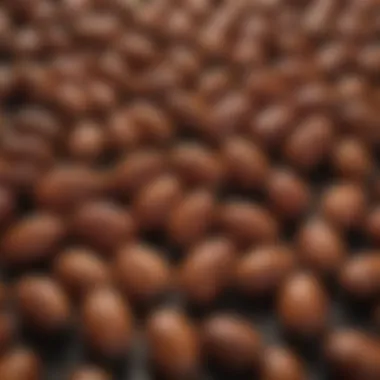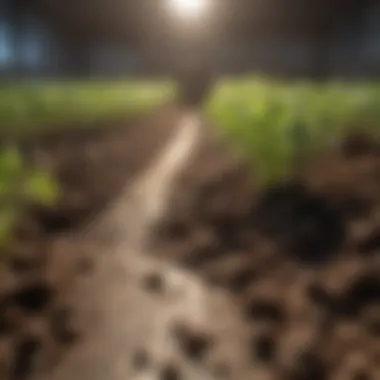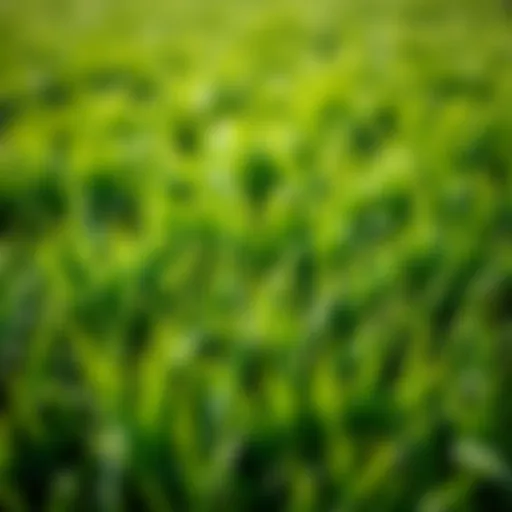Ultimate Guide for Planting Date Seeds Successfully


Intro
Growing date palms can be an enriching experience, not just for those looking to enhance their agricultural landscape but also for individuals seeking to dive into the world of horticulture. This section aims to set the stage for understanding the significance of date palms and what goes into successfully planting date seeds. Historically revered in regions such as the Middle East and North Africa, date palms have become a symbol of prosperity and longevity, capable of thriving in arid climates where few other crops can.
As this guide unfolds, you will discover the intricacies of seed preparation, the ideal conditions for germination, and the cultivation methods that yield vibrant date palms. With the right approach and knowledge, both amateur gardeners and seasoned farmers can cultivate these majestic trees that offer not just fruit, but a variety of ecosystem benefits.
Incorporating date palms into your agrarian practices can also serve both economic and nutritional purposes. These palms, yielding a fruit that is not only sweet but rich in nutrients, align with sustainable agricultural goals. The journey begins with laying a strong foundation in the nuances of planting date seeds—let's embark together.
Prologue to Date Seeds
Date seeds might not steal all the limelight in the world of agriculture, yet their role is profoundly significant. For those looking to cultivate date palms, understanding these seeds and their characteristics forms the bedrock of a flourishing agricultural journey.
The date palm, Phoenix dactylifera, is not just any tree; it provides fruit that has been cherished for millennia. It thrives in arid climates and yields fruits that are nutritious and tasty. Consequently, the importance of date seeds transcends mere propagation. It encompasses agricultural sustainability, economic viability, and nutritional benefits.
Understanding Date Palms
To grasp the significance of date seeds, one must first appreciate the date palm itself. This majestic tree, capable of soaring heights of 75 feet, is a survivor, able to withstand harsh conditions where few other plants can thrive. Its fan-shaped leaves not only provide shade but also contribute to the mystique of desert landscapes.
In historical contexts, date palms have been a cornerstone of civilization in many cultures, particularly in the Middle East and North Africa. They furnish food, shelter, and an ecosystem for countless species. By cultivating date palms, one taps into a rich heritage, entwined with the very fabric of societies across generations. Planting date seeds is akin to nurturing history itself— one might say they are sowing the seeds of civilization.
Significance of Date Seeds in Agriculture
Date seeds are invaluable for several reasons. First and foremost, they are a means of sustainably expanding date palm populations. As the global demand for dates rises, especially with increasing interest in health-conscious diets, the cultivation of date palms has emerged as a lucrative venture. In regions favorable to date growth, farmers can derive substantial income from their orchards, showcasing the economic potential tied to these seeds.
Moreover, using date seeds in propagation preserves genetic diversity. Planting seeds from various date varieties ensures a broader gene pool, which can contribute to resilience against pests and diseases. As agriculture grapples with climate change, such diversity becomes invaluable.
Additionally, there is a growing trend toward organic farming practices. By planting date seeds, farmers not only focus on fruit production but also promote soil health and ecosystem balance.
The journey from seed to palm exemplifies the delicate dance between nature and nurture; understanding this process empowers farmers to make informed decisions that can lead to productive outcomes.
In summary, the narrative of planting date seeds intertwines with elements of history, economy, biodiversity, and sustainable farming practices. By diving into this comprehensive guide, one embarks on an enlightening voyage through the robust world of date palm cultivation.
Preparing for Planting
Getting ready for planting date seeds isn’t just about throwing a few seeds in the dirt and hoping for the best. There’s a method to the madness, a series of steps that can improve the odds of getting those little seeds to sprout into robust date palms. The preparation stage is crucial because it lays the groundwork for successful germination and eventual growth, which is essential for any aspiring horticulturist or seasoned farmer looking to add value to their agricultural portfolio.
Selecting Quality Date Seeds
When it comes to planting date seeds, quality reigns supreme. As they say, you reap what you sow; so picking the right seeds is like setting the table for a feast. You want seeds that are plump, firm, and free of blemishes. Look for seeds that are uniform in size because consistency often translates to better germination rates. Generally, seeds sourced from reputable suppliers or directly from fresh dates tend to have a higher chance of success.
To get a better idea on how to select the best seeds, consider these factors:
- Source: Where you get your seeds from can make a world of difference. Trusted nurseries or local farmers often provide seeds with proven viability.
- Age of Seeds: Fresh seeds, ideally harvested within the last year, perform significantly better than older ones.
- Seed Variety: Different varieties of dates come with different characteristics, so it’s worth figuring out which type best suits your climate and soil conditions.
Once you've snatched up a handful of top-notch seeds, you’re ready to move to the cleaning stage.
Cleaning the Seeds
Cleaning date seeds might seem minor, but it's similar to washing your fruits before devouring them. It serves to remove any lingering residue that could hinder germination. The seeds might still be sticky or covered in pulpy remnants from the dates, which can attract molds and other unwelcome pests.
Here’s a simple method to ensure your seeds are spick and span:
- Rinse: Begin by rinsing the seeds under running water. A gentle rub will help dislodge any stubborn bits.
- Soak: Place the seeds in a bowl of water for about 24 hours. This makes it easier to clean off the remaining pulp.
- Scrub: After soaking, use a soft brush or cloth to scrub the seeds, ensuring all debris is removed.
- Dry: Finally, lay the seeds out on a clean towel to dry completely.
By the time cleaning is done, you’re one step closer to germination.
Soaking Seeds for Germination
Soaking the seeds is akin to waking them up from a long slumber; it can significantly boost germination rates by softening the seed coat. The soaking process serves as an invitation for the seed to take in moisture, making it ready to sprout when planted.
Here’s the lowdown on soaking:


- Duration: Keep the seeds immersed in water for about 24 to 48 hours, checking occasionally. You don’t want them to drown, so change the water if it gets cloudy.
- Temperature: Ideally, soak the seeds in a warm environment since warmth is conducive to activating the biological processes needed for germination.
- Post-Soak Handling: After soaking, give them a gentle rinse again, and then they’ll be prepped and primed for planting.
Before you know it, you’ll be on the cusp of taking those seeds from tiny nuggets of promise to budding palms reaching for the sky, rich with potential and flavor.
Optimal Conditions for Germination
Creating the right atmosphere for date seed germination is like setting the stage for a production—everything needs to align for it to flourish. The germination process is a delicate one, and when the conditions are off, it can derail the entire effort. It’s about more than throwing seeds into dirt; it’s a science laced with a bit of art, too. The optimal conditions can significantly affect the seed’s ability to sprout and thrive, leading growers to revel in the fruitful results or, conversely, leave them scratching their heads in confusion over what went wrong. Understanding these conditions sets the foundation for successful cultivation.
Ideal Soil Composition and pH Levels
Soil isn’t just dirt; it’s a living ecosystem. Choosing the right soil composition can make all the difference when germinating date seeds. Ideally, a well-draining soil high in organic matter is recommended for robust growth. A mix that contains sand, silt, and clay in proper ratios often yields great results. You don't want the soil to be too compact; it needs to breathe. Moreover, the pH level plays a crucial role here. A slightly acidic to neutral pH, typically around 6 to 7, is best for the date palm seeds. This ensures optimal nutrient absorption, fostering a supportive environment for the seeds.
Here are some tips for creating suitable soil conditions:
- Use loamy soil that drains well but retains enough moisture.
- Incorporate organic matter like compost to enhance nutrient content.
- Test the soil pH before planting, adjusting it if necessary using lime or sulfur.
Without the right soil, the seeds might struggle to germinate or develop weak root systems, which can lead to problems down the line.
Temperature and Moisture Requirements
Temperature is another piece of the puzzle—date seeds naturally hail from hot regions, so they prefer a cozy environment to get cozy themselves. The ideal germination temperature usually sits around 25°C to 35°C (77°F to 95°F). Anything outside this range might leave your seeds feeling a bit sluggish or, worse, completely dormant.
Moisture is similarly important, but this isn’t about flooding the seeds. Too much water can lead to rot, while too little can dry them out. The goal is to maintain a balance. A well-moistened environment, often achieved through controlled watering, keeps the seeds happy. Using plastic covers or humidity domes can help retain moisture without overdoing it.
To summarize the temperature and moisture essentials:
- Maintain warmth—a steady temperature around 30°C promotes rapid germination.
- Water carefully, keeping the soil consistently moist but not soaking wet.
"Understanding the twin pillars of temperature and moisture is crucial—both are key players in the seed germination game."
By ensuring the right conditions in terms of soil composition, pH levels, temperature, and moisture, growers can set the wheels in motion for a productive date palm garden. The seeds’ journey from dormancy to vitality depends on this very foundation, making it not just important but indispensable to successful cultivation.
Planting Techniques
When considering the journey of growing date palms, the role of planting techniques cannot be overstated. Choosing the right approach directly influences the seedlings' future health and productivity. Understanding these techniques helps ensure your efforts yield fruitful results, whether you are an agriculture farmer or just a gardening enthusiast.
Direct Sowing vs. Container Planting
Direct sowing and container planting each has its own sets of advantages. Direct sowing entails placing seeds directly into the ground, which can sometimes be the simpler route. This method favors those who trust the local soil conditions and want to establish the palm in its eventual location right away. However, keep in mind—if the weather decides to play tricks or if soil conditions aren’t ideal, the seeds may struggle to survive.
On the other hand, container planting allows for more control. By starting seeds in pots, you can nurture them in a more manageable environment. This method is particularly beneficial for climates that are harsh or unpredictable early in the growing season. Seedlings can be tended to with greater care, giving them a chance to develop sturdier roots before facing the elements outside.
Here are some considerations when deciding between the two methods:
- Soil Quality: Container planting allows for a controlled soil mix, which can be especially advantageous for germination.
- Mobility: Seedlings planted in containers can be moved to optimal light or sheltered from harsh weather.
- Seed Viability: Direct sowing might face challenges if seeds do not germinate due to poor soil preparation.
"The choice of planting technique can influence every aspect of the palm's growth journey. Choose wisely to pave the path to harvest."
Depth and Spacing Considerations
The depth at which seeds are sown and how far apart they are placed are essential factors in ensuring healthy growth. Planting too deeply could suffocate seeds or hinder their ability to emerge. Conversely, planting too shallowly exposes them to the whims of the weather. A general guideline for date seeds is to plant them about two to three inches deep. This allows adequate space for root development while still being near enough to the surface for successful sprouting.
Spacing is another key element. If seedlings are too crowded, they will compete for water and nutrients, leading to weaker, less productive palms. Generally, spacing out to at least five to six feet apart (once they are transplanted) is advisable. This distance promotes airflow and sunlight exposure—two critical components for healthy date palm growth.
In summary, whether you go for direct sowing or container planting, paying attention to the depth and spacing can't be overlooked. These planting techniques set the foundation for the date palms' growth trajectory.
Nurturing the Seedlings
Nurturing seedlings is a crucial step in the growth process of date palms. This phase can determine whether or not your efforts to cultivate date palms will bear fruit, literally and figuratively. Young date palms need attention and care to ensure they develop strong root systems and healthy foliage. Specifically, three areas require close management: watering, fertilization, and pest control. Successful nurturing encompasses an understanding of their needs and acting upon them proficiently.
Watering Techniques
While it may seem straightforward, the art of watering seedlings is anything but simple. Timing and technique play pivotal roles in ensuring that your date palms have adequate moisture without the risk of drowning. Newly sprouted seedlings often require more frequent watering due to their relatively shallow root systems. Here are some key points to consider:


- Frequency: Water the seedlings every two to three days, depending on environmental conditions like temperature and humidity.
- Method: Using a gentle watering can or a fine spray nozzle can prevent soil erosion and ensure even distribution of water. Direct watering methods, like a hose, can compact the soil or dislodge the seeds.
- Soil Moisture: Keep an eye on the soil's moisture level. A simple test, like sticking your finger an inch into the soil, can help assess if it's too dry or overly wet.
"Proper water management is often the difference between a healthy seedling and one that struggles to survive."
Fertilization Practices
Just like people need balanced meals to grow up strong, date seedlings require proper nutrition. Fertilization is an essential component of nurturing young plants. It provides the necessary nutrients that their current soil might lack. Here’s how to approach it effectively:
- Type of Fertilizer: Use a balanced, slow-release fertilizer, ideally one that’s low in nitrogen. High nitrogen levels can cause rapid leaf growth at the expense of root development.
- Application Timing: Start fertilizing a few weeks after the seedlings have germinated. This ensures that you’re not overloading them with nutrients too early in their growth.
- Application Method: Mix fertilizer into the top layer of soil or dissolve it in water for a nutrient-rich solution. Be cautious not to apply too much.
Pest and Disease Management
As much as nurturing seedlings is about providing what they need, it’s equally about protecting them from potential threats. Pests and diseases can wreak havoc on young date palms if not managed effectively. Here are some considerations to keep in mind:
- Regular Inspections: Keep an eye on your plants at least once a week. Look for signs of pests, such as unusual spots or webbing. Early detection can make a significant difference.
- Natural Remedies: Introduce beneficial insects, like ladybugs, or use neem oil as a preventive measure to deter pests. These methods are often less harmful than conventional pesticides.
- Disease Identification: Mold or wilting can be indicative of underlying diseases. If you notice these symptoms, it may be wise to consult with an agricultural expert or revert to soil care practices.
In sum, nurturing seedlings isn’t merely about watering them and throwing some fertilizer at the soil. It requires diligence and a close understanding of their specific needs in terms of hydration, nutrition, and protection. Taking the time to focus on these key elements will lead to stronger seedlings and more fruitful date palm cultivation.
Transplanting Young Date Palms
Transplanting young date palms is a critical phase in their cultivation, marking the transition from nursery to their permanent home. This step is not merely about moving a plant from one location to another; it involves careful consideration of various factors that ensure the young palms can thrive in their new environment. Getting this right can make a significant difference in the growth and productivity of your date palms.
Signs of Ready-to-Transplant Seedlings
Knowing when to transplant your date seedling is vital. Several indicators can help you determine if your young palms are ready to make the move to their new location:
- Root Development: A strong root system is key. When roots start to emerge from the bottom of the pot or the seedling container, it’s a signal that the plant needs more space.
- Leaf Size and Color: Healthy green leaves that are well-formed indicate that the plant is thriving. If the leaves are pale or stunted, it may be too early to transplant.
- Height: A height of at least 6 to 12 inches is often an indicator that a seedling is mature enough for transplanting. However, this depends on the specific variety you are growing.
- Stability: If the seedling can stand upright without support, it is generally a good sign it is ready for transplanting.
Transplanting at the right time helps minimize shock and ensures vigorous growth in the new environment.
Transplanting Procedures and Timing
The actual process of transplanting young date palms involves careful steps. One crucial aspect is timing; optimal transplanting occurs in spring or early fall when temperatures are milder. This helps reduce stress on the plants as they establish themselves.
To transplant:
- Prepare the New Site: Choose a well-drained area with plenty of sunlight. Ensure the soil is prepared similarly to the conditions the seedling was previously growing in.
- Water the Seedlings: A day before the move, thoroughly water the seedlings in their current pots. This helps ease the removal of the roots and soil while minimizing damage.
- Gently Remove the Seedlings: Carefully take the seedlings out of their pots, aiming to retain as much soil around the roots as possible.
- Planting: Dig a hole that’s about twice the width and depth of the root ball. Place the seedling in the hole and gently backfill with soil, ensuring no air pockets remain.
- Water Again: After transplanting, water the seedlings thoroughly to help them settle in.
Ultimately, patience is essential. Monitor your young date palms closely for the first few weeks after transplanting, watching for any signs of stress or adjustment. Regular watering, especially in the initial weeks, can help them recover from the move and begin thriving in their new home.
Transplanting is not just a step; it's a new beginning for your date palms. Treat it with care, and they will reward you with their growth.
By understanding these procedures and observing your seedlings’ readiness, you can ensure a successful transition that will benefit the long-term health and productivity of your date palms.
Long-Term Care and Maintenance
Long-term care and maintenance play a pivotal role in ensuring the healthy growth and production of date palms. These majestic trees not only require attention during their early stages but also demand continuous nurturing throughout their lifespan. By implementing a consistent care routine, growers can significantly enhance the yield and longevity of their date palms, making it a crucial topic in this guide.
Pruning Techniques for Healthy Growth
Pruning isn’t just a chore; it’s an art and science that keeps your date palms thriving. Regular trimming can stimulate growth, remove dead or diseased fronds, and improve the overall appearance of the palms. Here are some guidelines to help you with effective pruning:
- Timing is Key: The best time to prune is during the late winter or early spring when the tree is still dormant. This minimizes shock and supports healthy regrowth come the growing season.
- Identifying Dead Fronds: Use clean, sharp tools to carefully cut away any fronds that appear brown and dry. These not only detract from the palm’s aesthetics but can also harbor pests or diseases.
- Focus on the Interior: Thin out the inner fronds to improve air circulation and sunlight penetration, which is vital for optimal palm development.
- Avoid Over-Pruning: Too much trimming can stress the tree. Aim to remove no more than 20% of the total fronds at one time to maintain balance and vigor.
Pruning your date palms correctly can lead to healthier growth and better fruit production in the long run.
Managing Nutritional Needs
An optimal nutritional program guarantees that your date palms receive the essential nutrients for robust growth and fruiting. The following factors are critical in your management plan:
- Soil Testing: Regular soil testing helps identify which nutrients may be lacking. Ideally, the soil pH for date palms should be between 7.0 and 8.0 for optimal nutrient uptake.
- Fertilization Schedule: Date palms generally benefit from a balanced fertilizer applied in the early spring and again in mid-summer. The right mix typically includes nitrogen, phosphorus, and potassium, along with trace elements like magnesium and zinc.
- Organic Options: Incorporating organic matter, like compost or well-rotted manure, not only improves soil structure but also provides a steady release of nutrients over time.
- Water Soluble Fertilizers: During the hot months, using a water-soluble fertilizer can boost nutrient availability, especially if your palms show signs of nutrient deficiency, which includes yellowing fronds or stunted growth.
Maintaining an eye on these elements ensures that your date palms continue to thrive and produce healthy fruit year after year.


Potential Challenges
When it comes to growing date palms, understanding potential challenges is not just a good idea—it’s essential. Dates are not only delicious but can also be quite tricky to grow. If you're planning to get into this field, facing obstacles head-on can save a lot of time and effort down the line. Addressing these potential challenges helps ensure better yields and healthier trees. A well-informed approach can make all the difference.
Common Germination Issues
Germination is a critical stage in the life of a date seed. Unfortunately, several factors can interfere with the germination process. One primary issue lies with the acidity or alkalinity of the soil. Date seeds are somewhat finicky when it comes to pH levels. Excessively acidic or alkaline soils can halt germination in its tracks. Checking the pH levels and adjusting them as necessary will give your seeds a greater chance at sprouting.
Another common issue could be inadequate moisture. Seeds need a specific amount of water to break dormancy, and if they get too little, they won't germinate. Conversely, overwatering can lead to rotting, which is just as bad for seeds. A balance must be struck: keeping the seeds moist but not waterlogged is crucial.
In addition, the quality of the seeds plays a vital role. Old or improperly stored seeds may have reduced viability. They might look fine to the naked eye, but unless you’re using fresh seeds or well-preserved ones, germination rates may plummet. Performing a quick float test can help identify which seeds are good and which are better tossed out. Seeds that float are likely not viable.
Addressing Pests and Diseases
Once your date seeds have germinated and seedlings begin to emerge, the next hurdle becomes pests and diseases. These can wreak havoc before you even know they’re there. Aphids and spider mites are common offenders that can sap the strength from young plants. Regular checks on the underside of leaves can help catch infestations early.
Using organic insecticidal soaps can provide an effective defense against these critters without harming the environment. Meanwhile, fungal diseases, such as root rot, tend to be insidious. Proper drainage can help significantly reduce the risks of any water-related problems. It's wise to avoid excessive watering, especially if temperatures are low, as young palms are more susceptible during cooler months.
Another consideration is crop rotation and companion planting. By cultivating different plants nearby, the natural pest cycle can be disrupted, thereby making it less likely that pests will hone in on your date palms. Cover cropping can also improve soil health while minimizing pest pressure, simplifying maintenance.
In summary, keeping your eyes peeled for these potential challenges ensures that your date palms remain robust and productive. Both germination issues and pest control are foundational aspects of successful date palm cultivation. Like any worthwhile endeavor, growing date palms requires a bit of patience and foresight.
Harvesting Dates
Harvesting dates is a pivotal step in the journey of cultivating date palms. It marks the culmination of diligent care and attention bestowed upon the trees from seedling to maturity. The timing of this process plays a crucial role, not only determining the yield's quality but also influencing its market value. Knowledge about the right moment to harvest can optimize the fruit's flavor and nutritional value.
When approaching the harvest, understanding the specific elements linked to ripeness can help prevent the loss of precious dates due to over-ripening or improper handling. The benefits of timely harvesting extend beyond just the immediate yield; they include enhancing the longevity of the dates and ensuring their palatability for consumers.
Indicators of Ripeness
Identifying when dates are ripe can be somewhat of an art, and it requires meticulous observation. Not all varieties of dates mature at the same pace, so getting familiar with the specific characteristics of the variety being cultivated is key. Here are some common indicators to look out for:
- Color Change: The first, and perhaps most noticeable, sign is a change in color. Depending on the variety, ripe dates often transition from green to shades of yellow, brown, or even black.
- Texture: Ripe dates exhibit a plump and firm texture. As they gain ripeness, the skin becomes softer, making them more enjoyable to consume.
- Taste: It's advised to taste a few dates periodically. A ripe date should be sweet and flavorful; if it's still too tart, it may need more time on the tree.
- Dropping Fruits: A more physical sign to consider is the natural dropping of dates. While one or two fallen dates might not be alarming, a significant number can indicate that the time to harvest is upon you.
. "A watched pot never boils, but a watched date palm will tell you when it's ripe."
Careful attention to these indicators will lead to a well-timed harvest, maintaining the delicate balance of taste and texture.
Harvesting Techniques
Harvesting dates requires a blend of skill and care. Here are some techniques that can help ensure the process goes smoothly:
- Use of Tools: Hand-harvesting remains the popular method among seasoned growers. Using a long pole equipped with a sharp blade can help to gently cut the clusters of dates off without damaging the tree.
- Timing: Early morning or late afternoon is the ideal time to harvest. It helps to avoid the heat of midday which can cause the fruits to rupture or become overly dry.
- Careful Handling: Dates are surprisingly delicate. When collecting, take care to place them gently into baskets or crates lined with soft fabric to prevent bruising.
- Sorting: Once the dates are gathered, sorting them by size and ripeness can also be beneficial. Discarding any damaged or overly ripe fruits will ensure the quality of what you keep is top-notch.
Adopting these techniques allows for an efficient harvest that not only maximizes yield but also manages the delicate state of the fruits. After all, the final product should reflect the effort that was put into nurturing the date palms from the very beginning.
Epilogue and Future Considerations
As we reach the final note of this guide, it’s vital to reflect on the broader implications of planting date seeds. The conclusion serves not just as a wrap-up, but as an essential bridge to future endeavors in sustainable agriculture. The lessons learned from cultivating date palms extend beyond individual success stories; they can have a ripple effect in the agricultural community and even the environment at large.
Impact of Sustainable Practices
Implementing sustainable practices in date palm cultivation yields not only healthier plants but also promotes biodiversity. These practices include:
- Water conservation techniques: Use drip irrigation to minimize water wastage.
- Organic fertilization: Apply composted materials instead of synthetic fertilizers to enrich the soil without harming its health.
- Crop rotation: Alternating dates palms with other compatible crops can enhance soil fertility and reduce pest issues.
These strategies are critical as the world faces increasing environmental challenges. By adopting methods that respect the ecosystem, we contribute to soil preservation and reduced greenhouse gas emissions.
"Sustainability is the key to not just survival, but to flourishing ecosystems."
Encouraging Date Palm Cultivation
Encouraging date palm cultivation is not merely a recommendation; it’s a necessity in today’s agricultural dialogue. Date palms are incredibly resilient plants, able to withstand harsh and arid climates, making them suitable for regions where other crops might fail. Promoting date palm growth can assist in:
- Enhancing food security: Dates are nutrient-rich, providing not just energy but also essential vitamins and minerals.
- Boosting local economies: Date palms can create jobs in areas of harvesting, processing, and selling, promoting economic rejuvenation in rural areas.
- Cultural significance: Many communities hold their history and culture intertwined with the cultivation of date palms, underpinning their importance in culinary traditions and community events.
Investing in education and training programs can empower new farmers with knowledge about cultivating these remarkable trees. Online platforms, workshops, and local agricultural organizations can serve as conduits of information to spark interest and provide guidance.
In summary, the significance of integrating sustainable practices and fostering date palm cultivation goes beyond personal gains. It influences the socio-economic landscape of communities and offers hopeful avenues for future agricultural practices. By recognizing this impact, enthusiasts and farmers alike can steer their efforts towards a more sustainable future.







